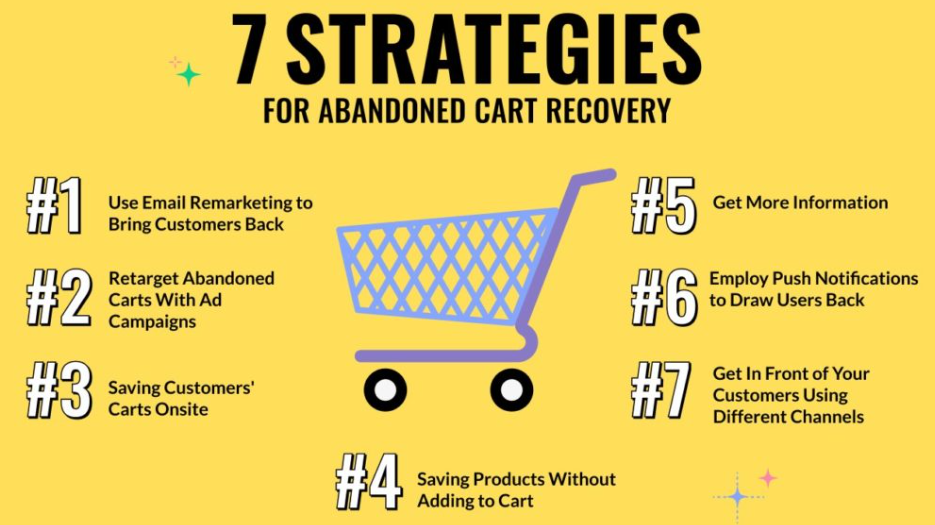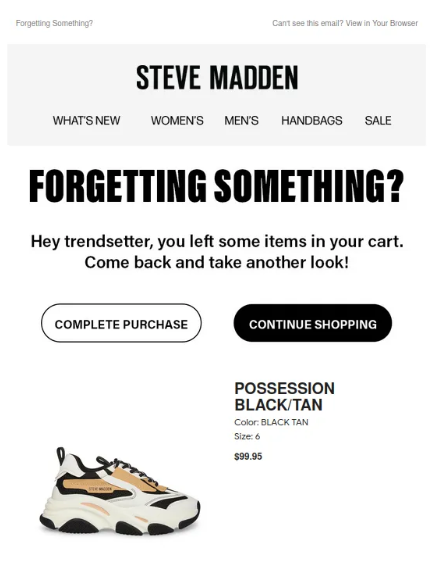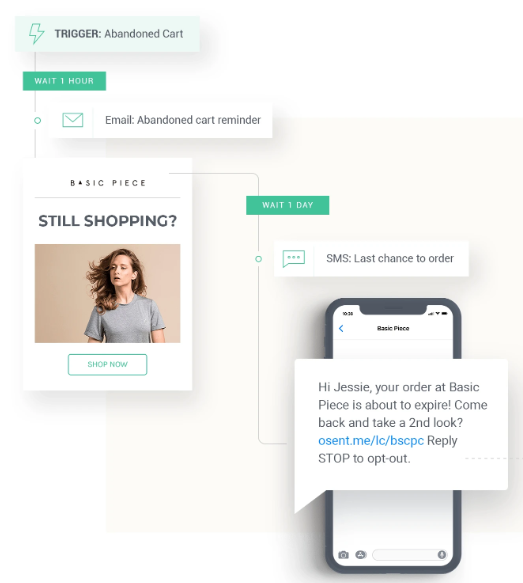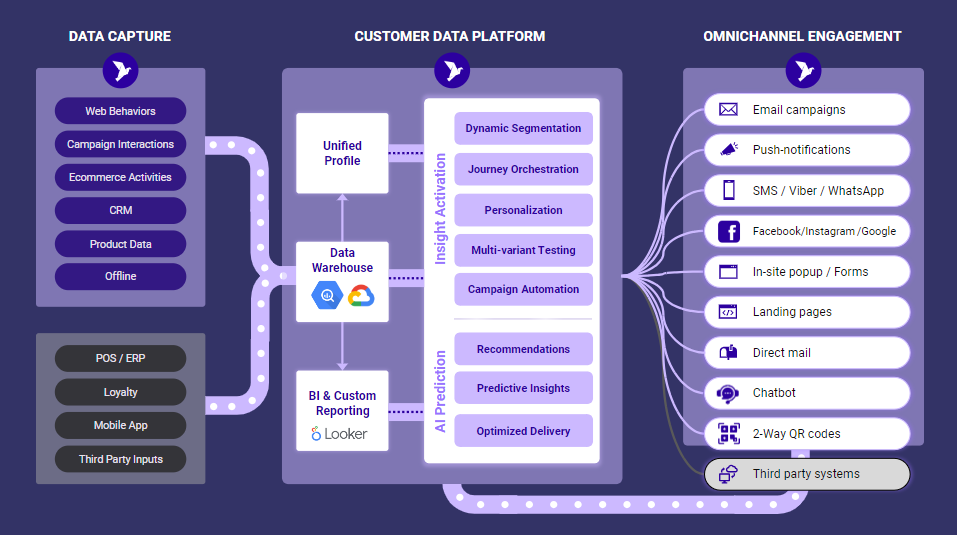With the rise in online shopping, cart abandonment poses a significant challenge for eCommerce retailers. On average, more than 70% of shoppers abandon their carts before completing a purchase. Implementing an omnichannel cart abandonment strategy enables retailers to recover some of these lost sales. Retailers embracing this approach utilize multiple channels to re-engage customers who have left their website without completing their purchase. An omnichannel cart abandonment strategy helps retailers address common reasons for cart abandonment and entices customers back in.
Potential customers exposed to retargeting ads are 70% more likely to return to a retailer’s site and finalize their transaction. Omnichannel tactics enhance these odds by allowing retailers to target individuals differently using various remarketing tools. They can act swiftly after a customer abandons their cart or gradually send messages to instill a fear of missing out.
What is an omnichannel cart abandonment strategy?

Omnichannel cart abandonment in marketing refers to a retargeting strategy in which a retailer uses multiple channels to re-engage customers who have abandoned their carts. Customers who leave their cart without completing their purchase trigger a series of messages on social media, website banners, email, and other channels, encouraging them to finish their purchase.
Key benefits of an omnichannel cart abandonment strategy (vs. traditional)
There are many reasons to choose an omnichannel approach over a traditional approach, starting with these benefits:
- Key Benefit #1: An omnichannel approach is more flexible than the traditional approach. It gives retailers the option to develop multiple targeted ads.
- Key Benefit #2: An omnichannel cart abandonment strategy improves message visibility as it displays it on various communication channels.
- Key Benefit #3: Retargeting customers in multiple places allows retailers to address different reasons for cart abandonment.
- Key Benefit #4: An omnichannel cart abandonment strategy is more customer-centric than the traditional approach, providing customers with retargeting offers that appeal to their unique needs.
- Key Benefit #5: An omnichannel approach gives retailers multiple ways to collect customer feedback and improve the checkout process. Even if they don’t make the sale, they can learn why a customer abandoned their cart and improve their processes in the future.
The key channels of an omnichannel cart abandonment strategy
Retailers have multiple options for creating personalized marketing messages to retarget people who have abandoned their carts. It is similar to cross-channel marketing in terms of available communication methods.
Email cart abandonment

Email is one of the more popular retargeting methods in a retail marketing strategy. On average, retargeting emails have an open rate of 40.14%. With email, retailers can use subject lines to create a sense of urgency and drive potential customers back to the website.
Common omnichannel cart abandonment examples for subject lines include:
- Did you forget something?
- Your shopping cart misses you
- Get 15% off your abandoned items!
- The Google Wi-Fi in your cart is going fast!
Including specifics in a subject line encourages potential customers to open it and reconsider their purchase. Appealing to a sense of urgency by highlighting limited quantities or offering a one-time discount makes it more enticing to complete the purchase.
Common use cases for email cart abandonment messages include reminding customers about forgotten items and addressing potential hesitations. Because emails don’t have character limits, retailers can use them to outline multiple reasons customers abandon their carts. For example, if a customer abandons their cart because of taxes and other fees, retailers can email them a coupon code to waive these fees.
Push notification cart abandonment

The majority of cart abandonment happens when people shop on their mobile devices. One of the most important advantages of push notifications is that they reach devices, not contacts, meaning retailers gain a broader audience by implementing an abandoned cart strategy on this channel. Push notifications from an app let retailers retarget these users immediately on the device they are currently using, increasing the chances for an immediate response. Retailers can also use them to retarget people on desktops or tablets, but users would have to opt in to push notifications first.
Like email, push notifications should contain action-oriented language that appeals to a customer’s fear of missing out. Sample messages include:
- Your cart awaits! Complete your purchase now!
- Limited-time discount! Finish your purchase within the next hour and get 10% off!
A retailer can also send an automated and dynamic push notification with a photo of the item in the customer’s cart, boosting personalization and appealing to the customer’s unique traits. Additionally, common use cases for push notifications include re-engaging people who use apps on mobile devices and retargeting people immediately after they have abandoned their carts. Since a retailer can use images of abandoned items, they can reignite interest. This is also a great tool for incentivizing faster checkout with a limited-time offer.
SMS/Viber cart abandonment

SMS is another way to retarget people on mobile devices. Text messages still have a high open rate of 98% compared to 20% for email. SMS cart abandonment messages should be short and strategic. Retailers should only send them to people who have opted in, so these messages usually land in the inboxes of people familiar with a brand.
Retailers looking to create personalized marketing messages with fewer restrictions can check out Viber. This business messaging app allows retailers to connect with customers in multiple countries without paying international messaging rates.
As part of an omnichannel cart abandonment strategy, SMS is most effective when retailers use short, action-oriented language. This is a good tool for sending limited-time coupons and other offers that inspire fast checkout.
For retailers offering physical locations as well as eCommerce websites, SMS is perfect for sending coupons customers can redeem in a store. Some customers may not want to complete purchases online because of long shipping times or concerns about online security. A coupon redeemable in-store addresses both of these objections.
Dynamic cart abandonment ads (Remarketing)

Dynamic cart abandonment ads are triggered online ads that pop up to people who have abandoned their carts. They work by displaying items customers have left in their carts or by showing similar items when a customer navigates away from a retailer’s website. Customers may see dynamic ads when using a search engine or scrolling their favorite social media feed.
Dynamic ads are a useful part of any retail marketing strategy. These ads should be specific to the potential customer without being overly salesy. Instead of using all caps and repetition, retailers should be straightforward and include specific offers in these remarketing ads, such as:
- 10% off casual sneakers for a limited time
- Come back and complete your purchase in the next hour and get free shipping
Retailers commonly use dynamic cart abandonment ads to target people who have not opted into text messages or email. These ads also allow retailers to re-engage potential customers for a longer period.
Since retailers can segment these ad campaigns, they can create variations on remarketing ads for different demographics. They can highlight different product features and benefits for each audience and run A/B tests to see which methods are most effective.
Dynamic on-site pop-up triggers

Dynamic pop-up ads are similar to remarketing ads, but they pop up on a retailer’s website. These ads serve as a way to keep customers from leaving without making a purchase.
Common approaches to dynamic pop-up triggers include messaging based on quantities in a customer’s cart. For example, if they have a specific pair of pants in their cart and leave before buying them, a pop-up may appear featuring the pants with the following message:
- We only have three more pairs of these pants in your size.
Dynamic pop-up ads on a retailer’s site are great for addressing common barriers to purchase before a customer leaves the site. Instead of waiting for them to depart, these ads encourage immediate purchase. Use them to capture customers concerned with shipping, taxes, and other hidden costs by offering a limited-time coupon.
Developing a 360-degree omnichannel cart abandonment strategy for the retail industry
Because cart abandonment rates are so high, every retail marketing strategy should include tactics for omnichannel cart abandonment. Here is how to develop one specifically for retail.
Step 1: Understand your abandonment problem

Not everyone will abandon carts for the same reasons. However, some common concerns keep customers from checking out. Understanding these reasons makes it easier to craft effective retargeting methods and offers.
Retailers can use surveys to assess why customers are leaving their site, or they can take advantage of cart abandonment tracking ways such as:
- Platforms that track active users, feature usage, page views, and other analytics. For instance, a customer data platform will be able to identify behaviors that drive people offsite before completing a purchase.
- Tools that address data privacy regulations by making it easy for customers to opt into messages. Retailers can also send surveys to the customers that didn’t complete their purchase.
Furthermore, segmenting abandoners lets retailers develop offers and messages that speak to their needs. For example, some people abandon their cart because the checkout process is confusing. They would respond to different messages than people frustrated by hidden fees.
You can use these tools for audience analysis and segmentation:
- Omnichannel customer engagement or marketing automation platforms include a segmentation tool to divide users.
- Business intelligence tools and customer data platforms offer multiple dashboards that analyze user behavior and generate reports that retailers can use to understand how to segment their audience.
After launching their cart abandonment strategy, retailers should continue monitoring abandonment rates with the solutions mentioned above. Tracking allows them to compare rates over time to see how their strategy works and how they can improve it.
Step 2: Craft compelling recovery messages

Effective messaging is critical to making an omnichannel cart abandonment strategy work. Personalized marketing can boost revenue by up to 40%, and this strategy works for abandoned cart emails. By understanding why customers abandon their carts, retailers can use keywords that spur action for specific audiences.
A variety of tools exist to start the personalization process, including:
- Customer engagement platforms, like ContactPigeon, offer personalization tools to create targeted messages that appeal to diverse audience groups.
Retailers can also create a sense of urgency and scarcity by using phrases such as “act now” and “limited time.” These will appeal to a customer’s fear of missing out and inspire potential customers to check out quickly by triggering their psychological purchase anxiety.
But creating copy that sells is art. These convenient tools will help retailers create urgent emails:
- With generative AI tools, retailers can proofread their messages and take into account suggestions for making them more effective.
- Marketing automation platforms with a variety of templates that create a sense of urgency. These templates should be easy to modify for personalization.
Moreover, incentives let retailers build a relationship with potential customers by removing some of the risk associated with purchase. Special discounts or limited-time offers help people feel more comfortable making a purchase and can inspire loyalty over time. Retailers can approach incentives in different ways:
- Loyalty programs offer an attractive reason for testing a new brand. They can also help foster a loyal relationship and inspire customers to spend more with a brand.
- Offering discount codes is a user-friendly way to give potential customers a limited-time deal without complicating the checkout process.
Finally, an omnichannel approach lets retailers target audiences in various ways, making it easier for them to take advantage of special offers. Data privacy laws make it harder to target customers with email and SMS messaging, so the omnichannel approach helps improve ad visibility.
Effective cross-channel marketing is simple with an omnichannel engagement platform. With this tool, retailers can manage their abandoned cart messages in one location and automate messages. This allows them to target cart abandoners in real-time with personalized messages. Moreover, customers having access to chatbots will aid them navigate the checkout process.
Step 3: Optimize the checkout process

Simplifying the checkout process is an easy tactic to reduce abandoned cart rates. Retailers should evaluate their design, product information, payment and shipping options, security, and customer satisfaction. They should also offer a guest checkout feature for people who don’t want to make an account. These tactics will provide a seamless shopping experience to visitors and customers.
Using a website builder and host specifically for eCommerce is one of the best ways to optimize the checkout process. These platforms include templates and other tools that allow retailers to create an effective, user-friendly checkout process.
Step 4: Continuously monitor and adapt
As customer preferences and habits evolve, retailers must adapt their omnichannel cart abandonment strategy. Regularly measuring key performance indicators such as conversion rates and cart abandonment rates lets retailers see which efforts are working and which may need some adjustment.
For example, if dynamic on-site pop-up ads generate multiple sales but emails don’t, a retailer will know they need to revise their subject lines and email layouts.
Omnichannel engagement tools are excellent means for measuring and adapting marketing strategies. These tools allow retailers to monitor metrics for each marketing channel and adjust their strategies accordingly. Many platforms offer handy reporting tools that provide insights into customer preferences and behaviors.

Key things to consider when designing an omnichannel cart abandonment strategy
After understanding the reasons for increased cart abandonment, retailers can perfect their overall strategy by considering the following tactics:
- Choosing the right technology solutions: Not all marketing platforms are made for retail. With a retail-specific platform, businesses can access features that help them automate effective campaigns.
- Integrating across channels: Each retargeting channel should include consistent messaging to improve user experience. A customer who sees two retargeting ads in different channels should recognize the brand.
- Mapping the customer journey: Customer journey mapping helps a retailer retarget customers depending on their relationship with the brand. Although many people at checkout are in the same stage of their journey, they may have different experiences with the brand. A brand can then tailor cart abandonment messages based on how long a customer has been with them.
How to measure the effectiveness of your omnichannel cart abandonment strategy

Tracking the following metrics at various stages of cart abandonment can provide retailers with critical data for perfecting the cart abandonment strategy.
- Shopping cart abandonment: Track the overall cart abandonment rate to see how it compares over time and whether your efforts work or they need adjustment.
- Email open rates: Track email open rates to understand what makes effective subject lines.
- Click-through rates: Track click-through rates on emails, SMS messages, and dynamic ads to determine the most effective tactics.
- Conversion rates: Track conversion rates for each channel to get an idea of which are most successful in transforming your website visitors into customers.
- Average order value: Track the average order value of every sale to see if special offers and deals encourage people to spend more and whether you can develop cross-selling and upselling strategies.
Other metrics to track
These metrics will help retail marketers understand how cart abandonment fits into their overall digital marketing strategy:
- Web traffic sources
- Page views
- Returning visitors
- Customer acquisition cost
- Cost per lead
- Customer lifetime value
Reporting tools to utilize
The following retail data analysis reporting tools offer valuable insights to inform omnichannel retail marketing.
- Customer data platforms: Retailers can compare customer demographics, behavior patterns, and previous purchases, or track the entire customer journey and other information. It will give them access to organized data that can be turned to actions.
- Marketing analytics platforms: These reporting tools contain dashboards that let retailers compare how their digital channels perform. The information can guide messaging automation and preferred channels by demographic.
- Omnichannel engagement platforms: User-friendly dashboards of omnichannel engagement platforms allow retailers to easily track how their abandonment cart messages perform across digital channels, including which are successfully driving people back to the website.
- Website analytics and search engine optimization: By tracking their most effective keywords, retailers can learn how to best leverage them in retargeting messages. They can use this information to create personalized cart abandonment ads that relate to items in a customer’s abandoned cart but may be more appealing.
How ContactPigeon’s powerful cart abandonment capabilities can improve your performance

Multiple retailers of all sizes have used ContactPigeon‘s Customer Data Platform to monitor and engage customers successfully using an omnichannel approach. Our platform includes multiple cart abandonment capabilities that make executing an omnichannel cart abandonment strategy a breeze, including:
- Campaign automation: ContactPigeon lets retailers automate personalized cart abandonment messages triggered by specific actions.
- Personalization: With this solution, personalization comes easily, as the platform makes suggestions for each campaign.
- Omnichannel capabilities: ContactPigeon offers a singular solution for developing email, push notifications, SMS and Viber messages, postcards, and more.
- Samaritan omnichannel chat: For customers who need a little help to finish their transaction, there is Samaritan. This natural language feature makes customer service available 24/7 for simple queries.
- Segmentation: ContactPigeon makes it easy to segment target audiences based on their preferences and behaviors. Group your contact list by purchase activity or their onsite behavior. With this tool, you can target people in a specific region with customized remarketing messages.
Do not abandon your growth, go omnichannel
Many visitors to your website will leave without completing a purchase, and even those who add items to their cart are likely to abandon it. An effective omnichannel cart abandonment strategy allows you to connect with these potential customers and address their concerns. Common reasons for cart abandonment include a complicated checkout process, mandatory account creation or app downloads, and hidden fees. Omnichannel remarketing through ads, emails, and messages helps resolve these issues and encourages customers to reconsider their purchases. Utilizing an omnichannel approach enables you to reach customers through their preferred communication channels.
Crafting a successful omnichannel cart abandonment strategy is made simpler with the aid of accurate data, which can be accessed through technologies like ContactPigeon. Book a Demo with our cart abandonment experts today to recover more of your valuable customers.

Let’s Help You Scale Up





